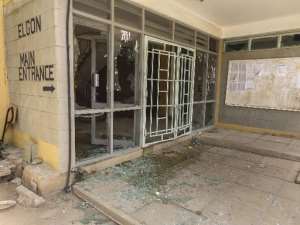
Nairobi (AFP) - A panicked student was killed and 150 more were hurt in a stampede at a Kenyan university campus when an electrical blast sparked fears of a new Islamist attack.
Some students jumped from the hostel from as high as the fifth floor at the University of Nairobi campus after the pre-dawn explosion, vice-chancellor Peter Mbithi told AFP.
The country is on edge after the April 2 attack by Somalia's Shebab insurgents on Garissa university that killed 148 people, almost all of them students.
Education Minister Jacob Kaimenyi said Sunday's explosion occurred at around 5:30 am while students were sleeping on the university's Kikuyu campus about 20 kilometres (12 miles) west of the capital.
"A power cable blew up outside the student hostel. The hostel itself was not affected, but the students thought it was an attack," said Mbithi.
"Some students jumped out," and "there was also a stampede", said Mbithi. "One student died after jumping from the fifth floor."
About 150 were injured, mostly lightly, while 20 remain in hospital for treatment.
The attack in Garissa, a town near the border with Somalia, was the deadliest on Kenyan soil since the 1998 bombing of the US embassy in Nairobi and followed the 2013 Westgate shopping mall massacre in the capital.
- 'Kenya's 9/11' -
"The way America changed after 9/11 is the way Kenya will change after Garissa," Vice President William Ruto said in a speech Saturday, according to an official statement.
The Kenyan government has come under harsh criticism for failing to prevent the Garissa massacre and for a bungled response.
Kenya has responded by asking the UN refugee agency to repatriate hundreds of thousands of Somali refugees by July, a move criticised by the UN refugee agency and rights groups.
"Instead of making refugees scapegoats, Kenya -- which is legally obliged to protect them until they can go home safely -- should find and prosecute those responsible for the Garissa massacre," said Leslie Lefkow, Human Rights Watch's Africa deputy director.
Somali refugees in Kenya number around 450,000, most of them at Dadaab, the world's largest refugee camp, the UNHCR said.
The Kenyan government previously sought the closure of Dadaab after Shebab's attack on the Westgate shopping mall in Nairobi in left at least 67 people dead, saying the camp was a breeding ground for Islamist militants.
Kenya also last week shut down 14 money transfer companies, vital for impoverished Somalia, over their suspected links to Shebab.
But aid agencies warned that the closure would mainly affect the poorest Somalis who depended on financial aid from relatives living in Kenya.
Authorities have so far detained five Kenyans and a Tanzanian suspected of connections to the Garissa university massacre.
They also identified one of the four gunmen killed during the Garissa siege as a Kenyan of Somali ethnicity, highlighting the Shebab's ability to recruit in the country.
Shebab millitants, who are fighting to overthrow Somalia's internationally-backed government, fled their power base in Somalia's capital Mogadishu in 2011, and continue to battle the Africa Union force, AMISOM, sent to drive them out.
The group has carried out a string of revenge attacks in neighbouring nations, including Kenya and Uganda in response to their participation in the AU force.




 Minority will expose the beneficial owners of SML, recover funds paid to company...
Minority will expose the beneficial owners of SML, recover funds paid to company...
 Prof. Opoku-Agyemang has ‘decapitated’ the NPP’s strategies; don’t take them ser...
Prof. Opoku-Agyemang has ‘decapitated’ the NPP’s strategies; don’t take them ser...
 Abubakar Tahiru: Ghanaian environmental activist sets world record by hugging 1,...
Abubakar Tahiru: Ghanaian environmental activist sets world record by hugging 1,...
 Prof. Naana Opoku-Agyemang will serve you with dignity, courage, and integrity a...
Prof. Naana Opoku-Agyemang will serve you with dignity, courage, and integrity a...
 Rectify salary anomalies to reduce tension and possible strike action in public ...
Rectify salary anomalies to reduce tension and possible strike action in public ...
 Stop all projects and fix ‘dumsor’ — Professor Charles Marfo to Akufo-Addo
Stop all projects and fix ‘dumsor’ — Professor Charles Marfo to Akufo-Addo
 Blue and white painted schools will attract dirt shortly – Kofi Asare
Blue and white painted schools will attract dirt shortly – Kofi Asare
 I endorse cost-sharing for free SHS, we should prioritise to know who can pay - ...
I endorse cost-sharing for free SHS, we should prioritise to know who can pay - ...
 See the four arsonists who petrol-bombed Labone-based CMG
See the four arsonists who petrol-bombed Labone-based CMG
 Mahama coming back because Akufo-Addo has failed, he hasn't performed more than ...
Mahama coming back because Akufo-Addo has failed, he hasn't performed more than ...
